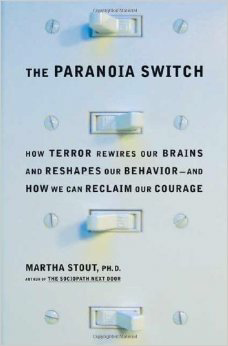Part of the Casswiki article series Books

The Paranoia Switch: How Terror Rewires Our Brains and Reshapes Our Behavior—and How We Can Reclaim Our Courage is a book by Martha Stout, first published in 2007. In this book, the author illustrates the American public’s fear-based responses to terrorist attacks, global warming, and natural disasters, and offers advice about how to curb those fears.
By using her psychological and neuro-psychological research on fear and terror, the author brings the reader to understand the nature of fear and terror, and how it was done to one’s mind. There are nine chapters in this book, but it is composed of four parts: a personal struggle with fear, the phenomenon of terrorism, protection against future fear, and a new hope. Throughout The Paranoia Switch, there is a discussion on terrorism, limbic wars, and fear brokers:
- Terrorism ⇒ We often hear this word, “terrorism,” daily in our lives. We hear it on the radio, watch it on the news, read it in the newspapers, and we would feel the fear when this word is mentioned everywhere we go. In her book, the author defined terrorism as “violence committed with the primary goal of manipulating the minds of the surviving population” (p. 27). So, why has terrorism becomes massive on global scale? It is because our fears are what fuels terrorism and our leaders are using our fears for their own selfish reasons. It is important for one to know, from reading this book, that terrorism does not always work unless it affects our minds.
Stout pointed out that the United States was a “habituated” country until that morning of September 11, 2001. It was not “used” to being exposed to acts of terrorism as other countries have had done, and it has experienced a profound shock. United States has yet to develop a coping mechanism to “short-circuit the paranoia switch”. So, instead, its paranoia switch is stuck and it is continuing to be “stuck” as long as the U.S. politicians keep feeding the public’s fear (p. 39).
-
Limbic Wars ⇒ The Limbic Wars are described in the fifth chapter, which Stout has included the American examples of Ku Klux Klan, the World War II internment of Japanese-Americans, and McCarthyism. And, she has detailed the six stages of Limbic War, including group trauma, fear brokers, scapegoatism, cultural regression, recognition and backlash, and regret and forgetting (p. 109-114). Her discussion of the limbic system and limbic resonance are clearly understandable and so are their roles on fear.
-
Fear Brokers ⇒ Fear Brokers are power-hungry individuals who use the public’s fear to pursue their private agenda (p. 110). Chapter Eight of Paranoia Switch outlined the ten behavioral characteristics of fear brokers. Stout pointed out that it is critical for the reader to identify and to know how to deal with the fear brokers. One of her suggestions was when one sees a fear broker speaking on television, to say to yourself: “that person wants to control me with fear” (p. 167).
Stout places a strong emphasis on responsibility for oneself when it comes to fear. She encourages the reader to have courage to face one’s fear by putting into action from knowing how fear was manifested in themselves and how it was being used. Politicians are using fear to keep people in check and under their control, but it does not have to be that way. In regards to nations, Stout has pointed out:
“If fear holds a democratic nation in thrall in the long term, causing the greater portion of its citizens to avoid thinking for themselves indefinitely, the best psychological prediction is that democracy will decline and eventually die.” (p. 201)
She also stressed that by giving into fear, by letting it affect us, we are letting the the fear brokers (e.g., our authoritarian leaders) to control us. In a sense, we are letting them to control our paranoia switch.
External links
- SotT: Limbic Warfare and Martha Stout’s “Paranoia Switch”
- C-SPAN: Book Discussion on The Paranoia Switch
See also
- Psychology
- Martha Stout
- Limbic resonance
